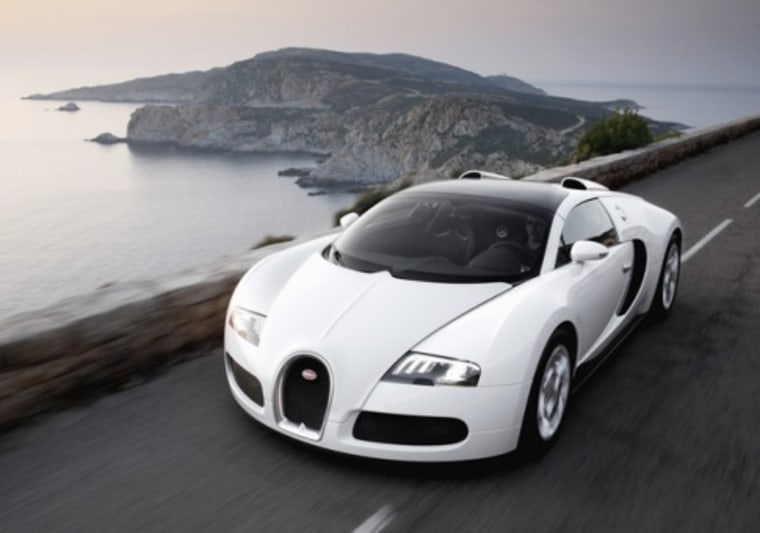If you're looking to travel in style and money's not a concern, you could opt for shares in a private jet, invest in a Louis Vuitton leather luggage set or spend six figures on any of a handful of street-legal, ultra-luxe cars.
It'll take a good three-quarters of a million dollars to own something like the SSC Ultimate Aero. The supercar produces 1,287 horsepower and features a carbon fiber-dashboard and center console with a digital temperature control unit and tire pressure monitor, for optimum driving conditions.
But if you drive the Aero, be prepared to be outclassed by owners of the Lamborghini Reventón. Only 20 drivers willing to part with $1.42 million will get to enjoy the car's fighter jet-inspired sharp edges and precise lines. You'll know the Reventón by its glass engine hood, solid aluminum fuel tank lid and opaque carbon fins screwed onto the black aluminum spokes on the wheels.
Stephan Winkelmann, president and CEO of Automobili Lamborghini S.p.A., calls the Reventón a "car without compromise" — it's based on the $354,000 Murciélago and created exclusively in Sant'Agata Bolognese, the heart of Italian motor design.
Both make our list of the world's most expensive cars. To compile it, we reviewed price lists from all the ultra-luxe ($300,000 and above) automakers who might have produced a contender this year for the top spot, including Bentley, Bugatti, Ferrari, Koenigsegg, Lamborghini, Leblanc, Maserati, Maybach, Mercedes-Benz, Pagani, Porsche, Rolls-Royce, Saleen, Shelby Super Cars and Spyker. We chose only cars that are currently in production and street legal, which eliminated the discontinued $653,000 Ferrari Enzo, as well as the $500,000 Mercedes-Benz SLR McLaren Roadster. In some cases we did not list all variations of a particular model. Prices do not include taxes, destination charges or upgrade options; some prices have been converted from euros to U.S. dollars. Not all of the vehicles on our list are sold in the U.S.
One similarity between last year's list and this year's? The brands themselves. While last year's tally saw more entries from Maybach and Pagani, aside from a few outliers (SSC Ultimate Aero and LeBlanc Mirabeau, among others) they, as well as Koenigsegg, Bugatti and Lamborghini, still produce the world's most expensive vehicles. These cars typically serve two purposes: as a posh chauffeured livery car, like the $1.4 million Maybach Landaulet, or as a screaming track machine, like the $1.3 million Koenigsegg CCXR.
And what that limited group is making is hyper-exclusive — production runs like the 150 expected for the French-built Bugatti Veyron 16.4 Grand Sport are considered high-volume (it takes seven months and a down payment of $487,000 to get one).
Part of the idea behind the low numbers is to protect the car's value; the fewer Veyrons there are, the more each one will be worth. The cars are special-ordered — made after an order is taken and customized to any specifications deemed necessary by the customer — to ensure automakers don't lose money on a vehicle left sitting around without a buyer. Exact figures on the profit margins for these privately owned companies are difficult to come by, but judging from the length and breath of their tenure (some have been around for decades), it's safe to say the sale of each vehicle generates a tidy sum.
The Koenigsegg Trevita is of the most exclusive on our list. "Trevita" means "three whites" in Swedish, a nod to the car's unique diamond-colored carbon fiber-weave bodywork and the fact that only three of them will be made. Inside, Trevita comes with all the best technologies: a hydraulic lift system, a tire monitoring system, a chrono instrument cluster, paddle-shifters and carbon fiber brakes. Under the hood, the 1,018-horsepower engine and 250-mph top speed promise much for any weekend thrill ride (lateral G-force can reach 1.5 G, and it'll get to 200 km/hour in 8.75 seconds). Price tag: $2.21 million.
The Pagani Zonda Cinque Roadster is another newcomer to the supercar winner's circle. This Italian-made machine is the new convertible version of the Pagani Cinque Coupe, the street-legal version of the Zonda R. The 678-horsepower, V12 engine is built by Mercedes-Benz's high-performance AMG division. It'll hit 62 miles per hour in 3.4 seconds, with a top speed of 217 mph — and it'll stop from 62 mph in just 2.1 seconds, thanks to the extremely expensive carbo-ceramic self-ventilated hydraulic Brembo brakes. A total of five Cinque Roadsters will be made.
Still, it's the Lamborghinis that have long inhabited expensive-car lists. These include the Reventón (its unique design and bloodlines make it coveted by collectors) and its convertible counterpart, the Reventón Roadster. These jet-like screamers are steeped in Italian luxury history: They're named after Reventón, the fighting bull owned by the Don Rodriguez family and known for killing the famous bullfighter Felix Guzman in 1943.
From the outside the angular Reventón duo is instantly recognizable. But Lambo reps say their sharp edges and reduced lines are there solely to fulfill the car's function; ornaments and decorations are totally foreign to the design and performance goals of any Lamborghini. Another design cue, and one of historic import, are the doors, both of which open upward. Ever since the Countach sports car was born in the mid-1970s, the doors-up effect has denoted Lamborghini's V12 line. The car also sports a brand new color option, an opaque, non-shiny greenish grey that shares the same name as the product.
Under the hood, the 650-horsepower engine gets to 62 mph in 3.4 seconds, with a top speed of 340 km/hour. Inside, the cockpit has Alcantara, carbon, aluminum and leather trim, with liquid crystal instrument displays and a g-force-meter, which measures drive forces when accelerating, and braking, and for speeding around corners. As Lamborghini likes to point out, a similar instrument is used in airplanes.
Matter of fact, with the going rate for private jets these days starting around $8 million, a plane may not be too far out reach — once the Trevita gets old and all.
